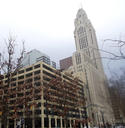It has been clear for years that net domestic migration to and from major metropolitan areas (over 1 million population) has been characterized by moving out of costly areas, like Los Angeles, the San Francisco Bay Area and New York to much less expensive areas, like Dallas-Fort Worth, Houston, Atlanta and Nashville. However, within these metropolitan areas, there are substantial variations. read more »
City Sector Model
Understanding Major Metropolitan Domestic Migration
- Login to post comments
A Change Is Gonna Come — Anyway
Frequent readers here may have seen me write about my experience growing up in 1970s Detroit. I’ve often said that seeking ways to improve the city and not abandon it, is what propelled me into a career in urban planning. I wanted to be a change agent for cities. Today, more than thirty years into my career, I’m proud of the stature cities have gained over that time; I’m proud of my contribution to it. However, I feel as if cities have risen in prominence in spite of the efforts of planners, not because of them. read more »
- Login to post comments
Housing Affordability and the Pandemic
The median price of homes in Auckland, New Zealand’s largest city, grew by $100,000 in February, reports the Real Estate Institute of New Zealand. That means prices were growing by $25,000 a week. The good news is that these are New Zealand dollars, which are only worth about 72 cents U.S., which means prices grew by “only” US$18,000 a week. read more »
A Vision for Cleveland
Part 1: Innovation and “the Next Silicon Valley”
It’s mayoral season in Cleveland and a number of viable candidates are lining up. With political candidacies inevitably comes political agendas. We will hear a lot about what a given candidate thinks has or hasn’t worked in Cleveland. We will also hear prognosticating about the future of Cleveland. read more »
- Login to post comments
Downtown Calgary: At Risk?
Downtown Calgary is a big deal (see photo above and photos following the text). Traditional American and Canadian downtown areas (central business districts or CBDs) are a holdover from the pre-auto era. Their geographical limits were largely set by the early Great Depression, with buildings that were well underway in planning by that time (such as the Chrysler Building and the Empire State Building in New York). CBD’s were far more dominant at that time. read more »
California and Urban Cores Dominate Overcrowded Housing
Concern about overcrowded housing has been heightened by its association with greater COVID-19 infection risk. As a disease transmitted by human proximity, exposure is increased by being in overcrowded and insufficiently ventilated spaces where sufficient social distancing is not possible. Exposure density for a person is intensified by the amount of time spent in such circumstances. read more »
- Login to post comments
Xi'an: Ancient and Modern: The Evolving Urban Form
Xi’an (pronunciation) is located in central China, on the Wei River, a tributary of the flood-prone Yellow River (Huang He). Xi’an is at the bottom of the “Ordos Loop” (see Surprising Ordos: The Evolving Urban Form), which is formed by the Yellow River’s sharp northward turn upstream at Lanzhou, toward Inner Mongolia (Nei Mongol). read more »
- Login to post comments
Latest Data Shows Pre-Pandemic Suburban/Exurban Population Gains
The latest complete American Community Survey (ACS) data, analyzed by the Demographia City Sector Model, indicates that population growth in the nation’s 53 major metropolitan areas (over 1,000,000 residents) continues to be, even before the pandemic, overwhelmingly suburban and exurban. read more »
- Login to post comments
Can Ford's Urban Gambit Survive Pandemic?
Ford Motor Co. unveiled grand plans this week to enhance its investment in the Corktown precinct of Detroit, envisioning creation of a 30-acre “mobility innovation district” around the iconic but crumbling Michigan Central train station that the automaker is restoring to make a hip urban locale for 2,500 engineers and tech people. read more »
- Login to post comments
Hangzhou: The Evolving Urban Form
Hangzhou is the capital of Zhejiang Province in China. Hangzhou’s historic core is located approximately 160 kilometers (100 miles) southwest of Shanghai and approximately 1,100 kilometers (675 miles) from Beijing .It is the largest municipality in Zhejiang, having passed Wenzhou within the last decade. read more »
- Login to post comments






















